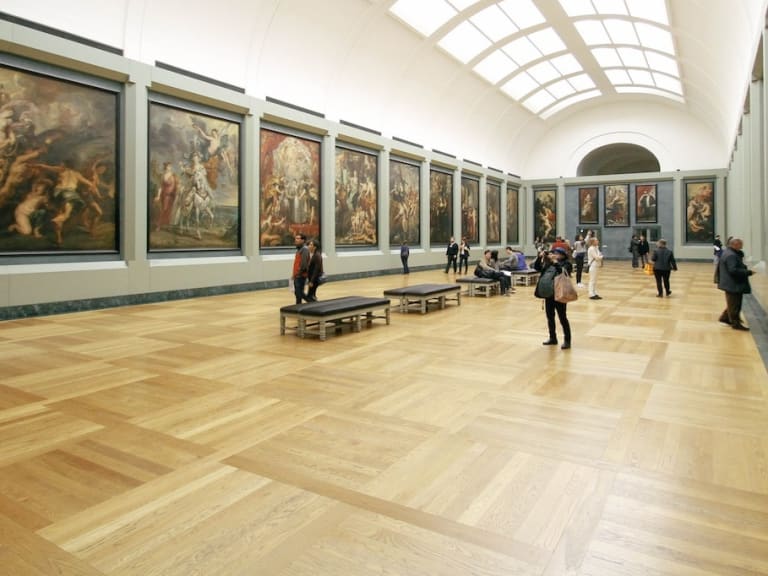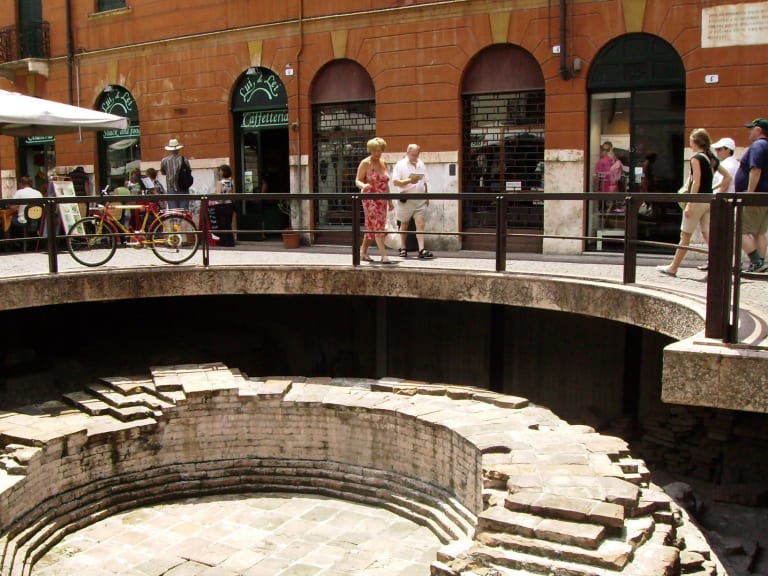The 10 Best Museums in Verona
Verona has some of the most interesting exhibits in northern Italy. From Juliet's House to the Fresco Museum, the city has much to tell through its rich history.

Vista aerea de Verona |©Maurice van Gestel
Since ancient times, Verona has been one of the cities that has promoted Italy's heritage. First as a cradle of resistance against invaders, then as the setting for Shakespeare's plays and now as one of the country's main tourist destinations, it has managed to amaze visitors and this has a lot to do with the displays and exhibits in its interesting museums.
Some of the best things to see and do in Verona include visiting Juliet's House, which houses the most famous balcony in world literature, the Archaeological Museum of the Roman Theatre, which has over 2000 years of history, the Museum of Frescoes, which is a testimony to the Renaissance, and the Castelvecchio Museum, which is the most famous museum in the city.
1. Juliet's House Museum, the home of the most famous balcony

The Juliet's House Museum is a medieval palace built in the centre of Verona and according to city records was the home of the Capulet family, one of the protagonists of William Shakespeare's dramatic composition Romeo and Juliet. This house has been standing since at least the 12th century and has undergone modifications, so that the only original feature is the entrance door. However, its balcony, which dates from a modification in 1936, is the most famous in the world.
It is on this balcony that one of the most important scenes of Shakespeare's play takes place and where one of the most famous dialogues between Romeo and Juliet takes place. Nowadays, it is the most visited place in Verona and besides having your photo taken with the front of the palace, writing your name and your partner's name on the wall and touching Juliet's sculpture, you can visit the museum inside the house, which rescues the family history of the Capulets.
Juliet's House is located in the city centre, so the best tours of Verona include a stop at the palace and also at Romeo's House, which is a few streets away but is not open to the public or converted into a museum.
You can also visit Juliet's tomb in Verona , which according to Shakespeare's play is located in the basement of the cloister of San Francesco del Corso, although this site usually disappoints visitors because of the impossibility of getting too close to the tomb and because the convent does not include other attractions.
Interesting facts
- Price... General admission to the museum has an initial cost of approximately 6 euros per person.
- Where... Piazzetta Navona, Verona.
- How to get there... Buses 31, 32, 33 and 95 and the city's hop-on-hop-off tourist buses.
2. Galleria Aquille Forti, the haven of modern art in Verona

Located in front of Piazza delle Erbe and on the way to the Lamberti Tower, from where you can catch a glimpse of one of the most beautiful open views of Verona, the Aquille Forti Art Gallery exhibits the main works of modern art that were donated from private collections up to the great avant-gardes of the 20th century.
In this museum, which is the haven of modern art in Verona, you can find central works of Italian modernism such as Meditation, by Francesco Hayez, or the untitled painting that Pompeo Marino Molmenti dedicated to Pia dei Tolomei. There are also paintings by Felice Casorati, Pino Casarini, Guido Trentini and Orazio Pigato, among other outstanding Italian artists.
In addition, from the exhibition building you can catch a glimpse of the Piazza delle Erbe, which is one of the main sites of the best gastronomic tours of Verona, and the courtyard of the Old Market, where if you plan to visit the city at Christmas you can discover the Santa Lucia flea market, one of the most traditional.
Interesting facts
- Price... Entrance to the museum has an initial cost of approximately 4 euros per person.
- Where... Cortile Mercato Vecchio 6, Verona.
- How to get there... Buses 33, 93 and 95 and the hop on-hop off tourist buses in the city.
3. Archaeological Museum of the Roman Theatre, one of the oldest in the city

The Roman Theatre, more than 2000 years old, is one of the oldest buildings still standing with its original structure in Verona, which went through invasions, battles and civil wars that more than once destroyed the buildings of the city. In addition to remaining operational as a stage for concerts and shows, the theatre also houses the Archaeological Museum.
The museum is a permanent archaeological exhibition centre displaying inscriptions, sculptures, mosaics and bronzes found in Verona and the surrounding towns of the province. It has been operating informally since 1857 and formally since 1924, making it one of the oldest museums in the city.
If you are an archaeology enthusiast, in this museum you can discover more than 600 works on display, plus another 200 in the outdoor areas of the cloister and the theatre. There you will also find funerary steles and altars, vases, Etruscan urns and Greek inscriptions, as well as ceramic bowls and metal furniture.
Interesting facts
- Price... Entrance to the museum has an initial cost of approximately 4.5 euros per person.
- Where... Regaste Redentore 2, Verona.
- How to get there... Buses 11, 12, 31, 32, 33 and 90 and the hop on-hop off tourist buses in the city.
4. The Children's Museum of Verona, the ideal place for children

The Children's Museum of Verona is an interactive exhibition for children up to 12 years old that includes displays, work areas, play areas and experimental spaces on the themes of science, technology, engineering, art and mathematics, making it an ideal choice if you plan to visit Verona with children.
This museum is divided into different areas and each of them deals with a different theme between water, light, mechanics, sound, logic and the human body. These interactive exhibits aim to stimulate informal learning and instruct children through experiments and hands-on experiences.
The Children's Museum focuses on family fun and learning for children, so if you plan to travel with children under 12 to Verona you can opt for this different alternative, which includes certificates for the children for participating in the activities and also information and instructions for replicating the activities outside the museum.
Useful information
- Price... Entrance to the museum has an initial cost of approximately 9 euros per person.
- Where... Via Santa Teresa 12, Verona.
- How to get there... Buses 41, 91, 92, 93 and 98 and the hop on-hop off tourist buses in the city.
5. International Centre of Photography, the paradise of the daguerreotype

Much of Verona's and Italy's photographic heritage is housed in the International Centre of Photography in Scavi Scaligeri, an underground exhibition space within a medieval complex, making a visit to this museum worthwhile not only for the displays of daguerreotypes and old photographs but also for the construction and architecture of the space.
The International Centre of Photography organises temporary exhibitions as well as some permanent ones. Among the latter you can find an exhibition of Robert Capa, the war photographer who was able to narrate the first half of the 20th century together with his partner Gerda Taro.
The tour of the International Centre of Photography lasts approximately 2 to 3 hours, so you can make the visit even if you are planning a short stay in the city. If this is your case, here is a list of activities you can do to discover Verona in 3 days
Interesting facts
- Price... Entrance to the museum has an initial cost of approximately 8 euros per person.
- Where... Cortile del Tribunale, Verona.
- How to get there... Buses 90, 93, 94 and 95 and the hop on-hop off tourist buses in the city.
6. Museum of Frescoes, a testimony of the Renaissance

Frescoes usually decorate government buildings, churches or public spaces, but for years many of these works, especially in Italy, were torn off the walls and sold. Today, many of these works rest in the Fresco Museum, which is a testament to the Renaissance, the era in which these works became popular.
This museum, which was promoted by the art historian and curator Giovanni Battista Cavalcaselle, is located in a building near the basement that houses Juliet's tomb and, in addition to Renaissance frescoes, also exhibits paintings from the Middle Ages, among which the cycle of the parade on horseback of Charles V and Pope Clement VII stands out.
You can visit the Fresco Museum and Juliet's Tomb on the same day or visit either attraction separately, so don't worry about the permanent queue at the entrance to the Convent of St Francis, as you can let them know that you only want to visit the museum and you'll be able to get a head start.
Interesting facts
- Price... Entrance to the museum has an initial cost of approximately 4.5 euros per person.
- Where... Via Luigi da Porto 5, Verona.
- How to get there... Buses 90 and 91 and the hop on-hop off tourist buses in the city.
7. Museum of Natural History, a typical exhibition in an atypical city

Verona is an unusual city, with many attractions, a large number of visitors on an almost permanent basis and a tourism oriented towards Romeo and Juliet. In this context the Natural History Museum offers an ordinary alternative, which stands out among the local museums and is ideal to visit with children or with the family.
In the Natural History Museum of Verona, housed in a historic building facing the Adige River, you can find a collection of fossils, which are the pearl of the show, including remains of fish, trees and plants that exceed 3 metres in height, creating the optical illusion of a petrified and enveloping forest.
The museum also has an area of stuffed animals which is a favourite with children and includes, among other species, bears, horses, dogs, giraffes, mammoths and a large number of birds and small animals.
Interesting facts
- Price... Entrance to the museum has an initial cost of approximately 4.5 euros per person.
- Where... Lungadige Porta Vittoria, Verona.
- How to get there... Buses 90, 92 and 98 and the hop on-hop off tourist buses in the city.
8. Nicolis Museum, the largest private collection of automobiles in Italy

One of the best excursions you can make from Verona is to the Nicolis Museum, which contains the largest private collection of automobiles in Italy. Located on the outskirts of the city in Villafranca, this exhibition consists of hundreds of cars, bicycles, motorbikes and even small planes.
Among the museum's gems are old models from Fiat, Ferrari, Isetta, Alfa Romeo, Lancia and other experimental or prototype vehicles of which very few were ever built. You can also see the first petrol-powered tricycle built by Karl Benz in 1885 and a DeLorean DMC 12, famous for being used as a time machine in the Back to the Future trilogy.
Keep in mind that the full tour of this museum can take between 2 and 3 hours and you have approximately an hour's drive from the city centre, so it is not a recommended option if you are planning a short stay. If that is your case, here is a list of activities so you can get to know Verona in 1 day.
Interesting facts
- Price... Entrance to the museum has an initial cost of approximately 14 euros per person.
- Where... Viale Postumia, Villafranca.
- How to get there... Buses 158 and 159.
9. Castelvecchio Museum, the most famous museum in Verona

The Castelvecchio Museum is one of the most important museums in the city and also in Italy, as it contains one of the largest and most interesting exhibits in the country, as well as a very beautiful architecture. In the more than 20 rooms of the museum you can discover samples of sculpture, painting and gold and silver work.
The museum also contains two 14th century Veronese bells, frescoes that belonged to the royal residences, ecclesiastical paintings from the Middle Ages and the Renaissance, 15th century Venetian works and equestrian statues that once stood in the town squares and were removed during the bombardments of the Second World War.
The Castelvecchio Museum also offers guided tours and if you plan to visit Verona during the Summer you can take part in the evening exhibitions, which include a complete tour of the museum's facilities as well as all the exhibits.
Interesting facts
- Price... Entrance to the museum has an initial cost of approximately 6 euros per person.
- Where... Corso Castelvecchio 2, Verona.
- How to get there... Buses 91, 92, 93, 94 and 95 and the hop on-hop off tourist buses in the city.
10. Palazzo Maffei, Verona's largest art collection

Palazzo Maffei, besides being a historic medieval building in Verona, is home to the largest art collection in the city, offering an eclectic itinerary among masterpieces, antiques, royal tableware and other items spanning 2000 years of history. This mixed scene can be discovered on a visit to the Maffei Palace Museum.
In total, the museum houses more than 500 works including paintings, sculptures, antique glass, Renaissance ceramics, silver and ivory works, wooden decorations, oriental art pieces and volumes of incunabula, because the Palazzo Maffei Museum also has one of the largest libraries in Verona.
Moreover, from the third floor of the building you can also enjoy one of the best views of the Piazza delle Erbe and enjoy the contemporary art exhibitions, most of whose works are by Italian painters.
In any case, if you are an art lover or simply want to see a museum cloistered in one of the most beautiful palatial residences in Verona, I advise you to visit the Palazzo Maffei.
Interesting facts
- Price... Entrance to the museum has an initial cost of approximately 14 euros per person.
- Where... Piazza delle Erbe 38, Verona.
- How to get there... Buses 93, 94 and 95 and the city's hop-on-hop-off tourist buses.
